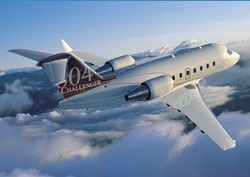Thu, Oct 01, 2015
Spirit Aeronautics Authorized To Upgrade Systems
The FAA has granted a Supplemental Type Certificate (STC) allowing Spirit Aeronautics to install Future Airspace Navigation System (FANS) 1/A capability in Bombardier’s Challenger 604 aircraft equipped with Rockwell Collins Pro Line 4 avionics.

The STC upgrade is straightforward and utilizes the current flight management system (FMS) and control display units (CDUs) coupled with a new communications management unit (CMU) to achieve integrated FANS 1/A capabilities. With FANS 1/A, Challenger 604 crews will be able to utilize preferred wind-efficient transatlantic routes which saves time and fuel. The upgrade also includes Automatic Dependent Surveillance-Contract (ADS-C) and Controller Pilot Data Link Communications (CPDLC) which reduces pilot workload and improves clarity and accuracy of pilot communications with Air Traffic Control (ATC).
“This is what Challenger operators have been waiting for and it is truly one of those occasions where they better move fast to reserve a slot because the equipment and capacity levels will be stretched to the limits to meet the mandated deadlines. There are simply more aircraft that need FANS upgrades than installation facilities and equipment OEM’s can keep up with”, said Tony Bailey, President and COO of Spirit Aeronautics. “Even though the STC is complete, FANS installations are very complex and require a qualified installation facility that is not only approved by the equipment OEMs but have years of experience working with complex avionics installations like Spirit Aeronautics.”
The concept of Future Air Navigation System (FANS) was introduced by the International Civil Aviation Organization (ICAO) in 1983 as a way to establish a standard protocol for oceanic communications for aircraft. The evolution of the system included the adoption of Automatic Dependent Surveillance (ADS) and Controller Pilot Data Link Communication (CPDLC) which allows for better aircraft control in congested airspace. Evolving technologies that utilize FANS are included in the FAA Next Generation Air Transportation System (NextGen) with regulatory mandates requiring compliance starting in December 2017.
(Image from file)
More News
Aero Linx: Model Aeronautical Association of Australia MAAA clubs are about fun flying, camaraderie and community. For over 75 years, the MAAA has been Australia’s largest fl>[...]
Touchdown Zone Lighting Two rows of transverse light bars located symmetrically about the runway centerline normally at 100 foot intervals. The basic system extends 3,000 feet alon>[...]
“Discovery and innovation are central to our mission at Virgin Galactic. We’re excited to build on our successful record of facilitating scientific experiments in subor>[...]
How To Get A Story On Aero-TV News/Feature Programming How do I submit a story idea or lead to Aero-TV? If you would like to submit a story idea or lead, please contact Jim Campbel>[...]
Student Pilot Reported That During Rotation, “All Of A Sudden The Back Of The Plane Kicked To The Right..." Analysis: The student pilot reported that during rotation, “>[...]
 ANN's Daily Aero-Linx (05.02.24)
ANN's Daily Aero-Linx (05.02.24) ANN's Daily Aero-Term (05.02.24): Touchdown Zone Lighting
ANN's Daily Aero-Term (05.02.24): Touchdown Zone Lighting Aero-News: Quote of the Day (05.02.24)
Aero-News: Quote of the Day (05.02.24) ANN FAQ: Contributing To Aero-TV
ANN FAQ: Contributing To Aero-TV NTSB Final Report: Cirrus Design Corp SR20
NTSB Final Report: Cirrus Design Corp SR20



